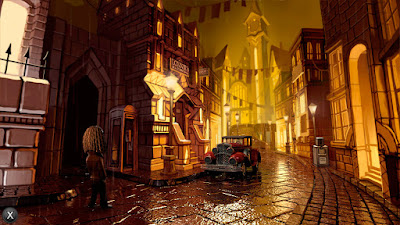Written by Anthony L. Cuaycong
Title: The Journey Down Trilogy (1, 2, 3)
Developer: SkyGoblin
Publisher: BlitWorks
Price: $49.97 (Ch 1 $9.99 / Ch 2 $19.99 / Ch 3 $19.99)
Genre: Adventure, Puzzle
Also Available On: PS4, Steam, XB1
It would be an understatement to describe Sweden-based SkyGoblin as a small independent videogame developer. Composed of a handful wearing a variety of hats, the company burst into the mainstream following the release of freeware adventure game The Journey Down: Over The Edge at the turn of the decade. Smartly, it leveraged the success to come up with a much-improved and highly expanded version that serves as the starting point for a point-and-click series of the same name. Given the limited resources it has had at its disposal throughout production, the commercially released Trilogy is nothing short of remarkable.
As with most other titles in the genre, The Journey Down: Chapter One is premised simply and succinctly. Main protagonist Bwana and sidekick Kito operate Gas ‘n’ Charter in a little corner of picturesque Kingsport Bay. They’re perfectly fine going through their otherwise-mundane existence, save for two concerns: their gas station is about to lose power due to unpaid bills and their charter service is literally grounded, relying on a single plane that hasn’t flown in two decades.
Enter university researcher Lina. Her search for the titular book which she believes contains information regarding the mythical Underland leads her to Gas ‘n’ Charter. The tome is found and prompts plans for a journey to the mysterious destination. However, Bwana and Kito must first secure the parts required to get their plane running before goons also interested in her discovery get to them, and it’s where The Journey Down digs into its puzzle-based hurdles.
Chapter Two begins where the first ends, and it delivers more of the same thrills, but better and in a more polished manner. The lead characters’ mission takes them to Port Artue, whose depressing state is perpetuated by the iron hand of local authorities, and more puzzles come between them and the Underland. By this time, it’s clear that SkyGoblin has found its groove, eschewing rote obstacles for seamlessly intertwined ones and delivering a tighter storyline through relevant exposition. Even as it occasionally gets bogged down in detail and dialogue, it manages to propel the narrative forward.
Needless to say, Chapter Three is the best, boasting of superior gameplay that rewards those who have seen fit to tag along for SkyGoblin’s eight-year affair with The Journey Down. In the final release, the puzzles become true avenues to enlightenment, with the script’s lighthearted tone conveying optimism even as Lina splits up with Bwana and Kito in order to thwart enemies on two fronts and ultimately prevail. Solid production values — the sound mix and voice acting included — contribute to a satisfying denouement.
Considering the lengths SkyGoblin has gone through (at one point even undertaking a crowdfunding campaign) to drive The Journey Down from conception to completion, the Trilogy is a hallmark of perseverance and dedication. The quality steadily improves with each new chapter, culminating in vibrant graphical and auditory offerings with a unique melding of African and Caribbean influences. The gameplay itself is straightforward, with the controls spot on and the challenges easy enough to overcome despite the absence of hints. Context clues that may be lacking in any given area are made irrelevant by pointing, clicking, dragging, and dropping, with seemingly obscure inventory items serving a purpose later on.
In sum, The Journey Down Trilogy is a viscerally pleasing experience well worth the effort to play through. The three chapters are available on the Nintendo eShop as separate and distinct purchases, but SkyGoblin has set them up to be best enjoyed chronologically and together. Featuring inviting design choices and tests that don’t frustrate but, rather, encourage, they’re a collective testament to the power of ingenuity and creativity.
THE GOOD
- Outstanding, if unusual, art direction and sound design
- Involving storyline
- Intuitive controls
THE BAD
- Subsequent chapters contain no preambles, negating the value of standalone purchases
- Puzzles are often too easy even for casual gamers
- Quality is uneven, albeit steadily improving
RATING: 8/10






No comments:
Post a Comment